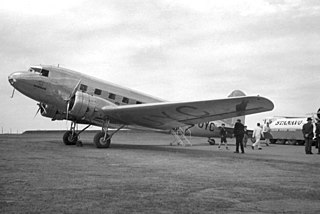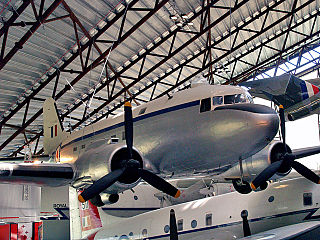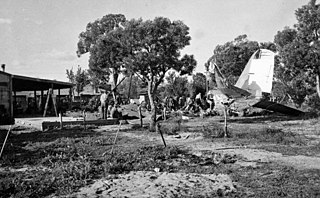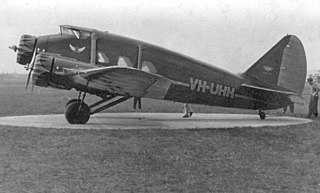
The de Havilland Express, also known as the de Havilland D.H.86, was a four-engined passenger aircraft manufactured by the de Havilland Aircraft Company between 1934 and 1937.

Aviation safety is the study and practice of managing risks in aviation. This includes preventing aviation accidents and incidents through research, educating air travel personnel, passengers and the general public, as well as the design of aircraft and aviation infrastructure. The aviation industry is subject to significant regulation and oversight.

On 10 June 1960, a Fokker Friendship passenger aircraft operated by Trans Australia Airlines (TAA) was on approach at night to land at Mackay, Queensland, Australia when it crashed into the sea. All 29 people on board Trans Australia Airlines Flight 538 were killed.

Surinam Airways Flight 764 was an international scheduled passenger flight from Amsterdam Airport Schiphol in the Netherlands to Paramaribo-Zanderij International Airport in Suriname on a Surinam Airways DC-8-62. On Wednesday 7 June 1989, the flight crashed during approach to Paramaribo-Zanderij, killing 176 of the 187 on board. It is the deadliest aviation disaster in Suriname's history.

On 26 June 1950, a Douglas DC-4 Skymaster aircraft departed from Perth, Western Australia, for an eight-hour flight to Adelaide, South Australia. It crashed 22 minutes after take-off, 35 miles (56 km) east of Perth Airport. All 29 occupants were killed in the accident; one initially survived, but died six days later. As of 2024, it remains tied with the 1960 crash of Trans Australia Airlines Flight 538 as the worst aviation accident in Australia's peacetime history, at 29 fatalities each. By death toll, they are only beaten by the 40-fatality Bakers Creek air crash which occurred during World War II.

Australian National Airways (ANA) was Australia's predominant aerial carrier from the mid-1930s to the early 1950s.

Pakistan International Airlines Flight 268 was an Airbus A300, registration AP-BCP, which crashed while approaching Kathmandu's Tribhuvan International Airport on 28 September 1992. All 167 people on board were killed. Flight 268 is the worst accident in the history of Pakistan International Airlines, and the worst ever to occur in Nepal.

The Kyeema airline crash occurred on 25 October 1938 when the Australian National Airways Douglas DC-2 Kyeema, tail number VH-UYC, flying from Adelaide to Melbourne, commenced final approach to Essendon Airport through heavy fog and crashed into the western slopes of Mount Dandenong, also known as Mount Corhanwarrabul, killing all 18 on board instantly.

Nundle is a village in the New England region of New South Wales, Australia. It was formerly the centre of Nundle Shire, but most of this area, including the village of Nundle, was absorbed into Tamworth Regional Council in 2004. The village is 400 km north of Sydney and about 56 km south east of Tamworth past Chaffey Dam via a good sealed road. In the 2006 census Nundle had a population of 289. Nundle is located at the southern end of Fossickers Way.

The 1961 Derby Aviation crash refers to the fatal crash of a Douglas Dakota IV, registration G-AMSW, operated by Derby Aviation, the forerunner of British Midland Airways, on the mountain of Canigou, France, on 7 October 1961. All 34 on board were killed.

On the evening of 30 November 1961, Ansett-ANA Flight 325, a service from Sydney to Canberra, Australia, operated by a Vickers Viscount 720, broke up in mid-air and crashed shortly after takeoff, when it encountered a severe thunderstorm. All 15 people on board were killed.

On Sunday 10 March 1946 a Douglas DC-3 aircraft departed from Hobart, Tasmania for a flight to Melbourne. The aircraft crashed into the sea with both engines operating less than 2 minutes after takeoff. All twenty-five people on board the aircraft died. It was Australia's worst civil aviation accident at the time.
William Ballantyne Simpson was an Australian soldier, barrister, Army officer, administrator and Supreme Court judge.

On 2 July 1949 a Douglas DC-3 aircraft departed from Perth Airport for a night flight of 441 nautical miles (817 km) to Carnarvon. The aircraft climbed to a height of about 500 feet (150 m) and then spiralled almost vertically to the ground, killing all 18 people on board. It crashed about one mile north of Perth Airport and burned for over one hour. At the time, it was the worst civil aviation accident in Western Australia.

On 10 March 1949 a Lockheed Lodestar aircraft became airborne at Coolangatta, Queensland, Australia for a flight to Brisbane. Before reaching a height of 300 feet (90 m) it suddenly pitched nose-up, stalled and crashed onto its belly beyond the end of the airstrip.
Kempsey Airport is a small airport located in Aldavilla 4 nautical miles west of Kempsey, New South Wales, Australia. The airport is operated by Kempsey Shire Council and is mainly used for general aviation activities, including flight training, skydiving and emergency services uses. There are currently no scheduled passenger services to Kempsey.
Sir George Augustus Pape was an Australian lawyer and judge. He became a Queen's Counsel in 1955 and a judge in the Supreme Court of Victoria in 1957. He was knighted in 1968 and retired from the Supreme Court in 1975.

The 1937 Airlines of Australia Stinson crash was an accident which occurred on 19 February 1937. The Airlines of Australia Stinson Model A airliner disappeared during a flight from Brisbane to Sydney, carrying five passengers and two pilots. Both pilots and two passengers were killed in the crash. One of the surviving passengers died while attempting to bring help to the other survivors.


















